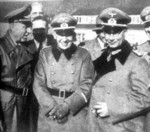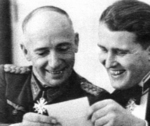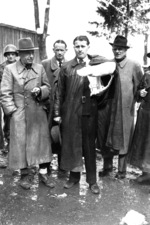Walter Dornberger
| Surname | Dornberger |
| Given Name | Walter |
| Born | 6 Sep 1895 |
| Died | 27 Jun 1980 |
| Country | Germany, United States |
| Category | Science-Engineering |
| Gender | Male |
Contributor: C. Peter Chen
ww2dbaseWalter Dornberger was born in Gießen in central Germany in 1895. He enlisted in the Germany army in 1914 and was promoted to the rank of lieutenant in the artillery before becoming captured by United States Marines. He was a prisoner of war between 1918 and 1920; because of multiple escape attempts, he spent a good deal of time in solitary confinement. He earned a master's degree in mechanical engineering in the spring of 1930 from Technische Hochschule Charlottenburg in Berlin, Germany. Shortly after, in Apr 1930, he was appointed to the Ballistics Council of the Weapons Department of the Germany Army to secretly develop a liquid fuel rocket. He was present at the Kummersdorf weapons research center near Berlin in Dec 1932 when a rocket being lit by Wernher von Braun exploded. In Oct 1934, he was given command of a powder rocket training battery at Königsbrück; this would be his last military command. In 1935, he received a honorary doctorate degree from the same institution, arranged by Dean of the Faculty of Military Technology Colonel Karl Emil Becker. In May 1937, he was transferred to the Peenemünde Army Research Center on the Baltic Sea coast, where he was to focus on the development of rockets. In Sep 1942, he was given operational responsibility of the V-1 flying bomb and V-2 rocket research programs. On 3 Oct 1942, a V-2 rocket was launched successfully. On 7 Jul 1943, Major General Dornberger, along with Braun, was flown to the Wolfsschanze headquarters to meet with Adolf Hitler, where they would present the German leader a film of the successful Oct 1942 V-2 rocket launch. In Dec 1944, he was given complete control over the development of anti-aircraft rocket development. In Feb 1945, as Soviet troops advanced, he relocated his headquarters from Schwedt-an-der-Oder to Bad Sachsa near Göttingen in central Germany. Around this time, he hid his papers near Bad Sachsa; these papers were later found by troops of US 332nd Engineer Regiment. Two months later, he relocated again to Haus Ingeborg in Oberjoch near Hindelang in southern Germany. On 2 May 1945, Dornberger, Braun, and five others departed Haus Ingeborg for Austria; after passing through Adolf-Hitler-Pass (now Oberjoch Pass) they ran into American troops and became detained. They were officially listed as under arrest on the following day. He was transferred to London, England, United Kingdom in mid-Aug 1945 and was investigated for the use of slave labor in the production of V-2 rockets, which was against the rules of war. He was released from imprisonment in 1947 and then was brought to the United States as a part of Operation Paperclip, which recruited German talent for American scientific research. Between 1947 and 1950, he worked with the United States Air Force in the development of guided missiles. Between 1950 and 1965, he worked for the Bell Aircraft Corporation, reaching the position of a vice president by the time he departed from the company; among the many projects he worked on included the revolutionary GAM-63 Rascal supersonic air-to-surface nuclear missile. After his retirement in 1965, he moved to Mexico for some time before returning to Germany. He passed away in southwestern Germany in 1980.
ww2dbaseSources:
Annie Jacobsen, Operation Paperclip
Wikipedia
Last Major Revision: Dec 2014
Walter Dornberger Interactive Map
Photographs
 |  |  |  |
Walter Dornberger Timeline
| 6 Sep 1895 | Walter Dornberger was born in Gießen, Germany. |
| 1 Oct 1934 | Walter Dornberger was given command of a powder rocket training battery at Königsbrück, Germany. |
| 27 Mar 1942 | Walter Dornberger proposed production plans and the building of a rocket launching site somewhere on the coast of the English Channel. |
| 8 Jan 1943 | Walter Dornberger and Werhner von Braun met with Albert Speer. During the meeting, Speer informed the rocket research leaders that construction of a rocket launching site along the English Channel coast would soon commence. |
| 7 Jul 1943 | Walter Dornberger, Werhner von Braun, and Ernst Steinhof met with Adolf Hitler, Albert Speer, Wilhelm Keitel, and Alfred Jodl at the Wolf's Lair (Wolfsschanze) in Rastenburg, Germany (now Kętrzyn, Poland). Hitler was thoroughly impressed with the progress of rocket research. |
| 6 Apr 1945 | Walter Dornberger moved his headquarters from Bad Sachsa to Haus Ingeborg in Oberjoch in the Allgäu mountains in southern Germany. |
| 2 May 1945 | Walter Dornberger departed Haus Ingeborg in Oberjoch in the Allgäu mountains in southern Germany for Austria; his group ran into American troops after passing through Adolf-Hitler-Pass (now Oberjoch Pass). |
| 3 May 1945 | Walter Dornberger, having already been detained by American troops on the previous day in Austria, was officially listed as under arrest. |
| 27 Jun 1980 | Walter Dornberger passed away in Obersasbach, Germany. |
Please consider supporting us on Patreon. Even $1 per month will go a long way! Thank you. Please help us spread the word: Stay updated with WW2DB: |
» Operation Paperclip
- » 1,167 biographies
- » 337 events
- » 44,617 timeline entries
- » 1,244 ships
- » 350 aircraft models
- » 207 vehicle models
- » 376 weapon models
- » 123 historical documents
- » 261 facilities
- » 470 book reviews
- » 28,520 photos
- » 365 maps
Fleet Admiral Chester W. Nimitz, 16 Mar 1945
Please consider supporting us on Patreon. Even $1 a month will go a long way. Thank you!
Or, please support us by purchasing some WW2DB merchandise at TeeSpring, Thank you!